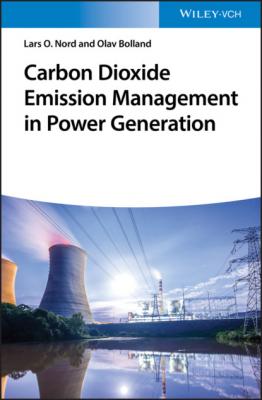Carbon Dioxide Emission Management in Power Generation. Prof. Lars O. Nord
Читать онлайн.| Название | Carbon Dioxide Emission Management in Power Generation |
|---|---|
| Автор произведения | Prof. Lars O. Nord |
| Жанр | Химия |
| Серия | |
| Издательство | Химия |
| Год выпуска | 0 |
| isbn | 9783527826650 |
316 308
317 309
318 310
319 311
320 312
321 313
322 314
323 315
324 316
325 317
326 318
327 319
328 320
329 321
Carbon Dioxide Emission Management in Power Generation
Lars O. Nord
Olav Bolland
Authors
Prof. Lars O. Nord
NTNU - Norwegian University ofScience and Technology
Department of Energy and ProcessEngineering
Kolbjørn Hejes vei 1B
NO-7491 Trondheim
Norway
Prof. Olav Bolland
NTNU - Norwegian University ofScience and Technology
Faculty of Engineering
Høgskoleringen 6
NO-7491 Trondheim
Norway
Cover Image: © zhongguo/Getty Images
All books published by Wiley-VCH are carefully produced. Nevertheless, authors, editors, and publisher do not warrant the information contained in these books, including this book, to be free of errors. Readers are advised to keep in mind that statements, data, illustrations, procedural details or other items may inadvertently be inaccurate.
Library of Congress Card No.:
applied for
British Library Cataloguing-in-Publication Data
A catalogue record for this book is available from the British Library.
Bibliographic information published by the Deutsche Nationalbibliothek
The Deutsche Nationalbibliothek lists this publication in the Deutsche Nationalbibliografie; detailed bibliographic data are available on the Internet at <http://dnb.d-nb.de>.
© 2020 Wiley-VCH Verlag GmbH & Co. KGaA, Boschstr. 12, 69469 Weinheim, Germany
All rights reserved (including those of translation into other languages). No part of this book may be reproduced in any form – by photoprinting, microfilm, or any other means – nor transmitted or translated into a machine language without written permission from the publishers. Registered names, trademarks, etc. used in this book, even when not specifically marked as such, are not to be considered unprotected by law.
Print ISBN: 978-3-527-34753-7
ePDF ISBN: 978-3-527-82664-3
ePub ISBN: 978-3-527-82665-0
oBook ISBN: 978-3-527-82666-7
Preface
The International Panel on Climate Change (IPCC) Fifth Assessment Report (IPCC-WG1 2013) states that it is extremely likely (≥95% probability) that human activities caused more than half of the observed increase in global average surface temperature from 1951 to 2010. In order to reduce the man-made warming, concerted action to mitigate emissions of greenhouse gases is now needed. The main greenhouse gas generated by human activities is carbon dioxide (CO2). Other important greenhouse gases produced from human activities are methane (CH4) and nitrous oxide (N2O). CO2 is produced mainly by the combustion of fossil fuels in the power sector, manufacturing industry, and in the transport sector and also in the production of energy carriers and services. Projections by the International Energy Agency indicate that fossil fuels will be the dominant source of energy until 2030 and most likely beyond. It is, therefore, becoming increasingly important that we develop and deploy mitigation technologies that can make significant reductions in CO2 emissions in all sectors.
This book covers both CO2 capture technologies as well as power generation technologies. These are strongly coupled when capturing CO2 from power plants. CO2 capture technologies have many of the same components found in various chemical plants, while power generation technologies is a different world where power engineering and mechanical engineering rule the ground. CO2 capture makes it necessary to deal with these areas simultaneously, with a communication between a more diversified group of engineers and scientists that is common today. It is even more complex than that because CO2 capture is also strongly coupled to transport and storage of the CO2, which brings geologists and reservoir engineers into the game. Another aspect of this is that if CO2 capture and storage make sense, it needs to be done on a very large scale – with big implications to not only the energy industry but also to the society in general. This makes it necessary to have the economists and social sciences taking part in the development of CO2 capture and storage technologies.
Note that biomass as fuel and Bio-CO2 capture and storage (CCS) are not included in the book. Although many of the same aspects on power plant technologies and CO2 capture as for fossil fuels also apply to biomass, we believe that this subject deserves a separate treatment together with other potential negative CO2 emission technologies.
Both authors have a mechanical engineering background. Olav Bolland was active in the CCS field from the late 1980s until 2017 and has led and participated in many national and European projects within CCS. Lars Nord worked in the power generation industry for seven years before returning to academia in 2006 to pursue a PhD degree within CCS under Bolland's supervision. This work has continued until now. Both Bolland and Nord are working at NTNU – The Norwegian University of Science and Technology in the Faculty of Engineering.
Some notes on terminology in the book are as follows:
The commonly used term oxy-fuel (or oxyfuel) is not used in this book because of the misconception of having an oxidised fuel, like nitromethane (CH3NO2). Instead, the term oxy-combustion is used, which the authors believe describes the combustion in an oxygen-enriched environment more accurately. The term oxy-fuel combustion has also been extensively used in the literature.
The off-gas coming from a power plant, engine, or any other type of combustion device is sometimes referred to as flue gas and other times as exhaust gas. The latter is mostly used for gas turbines and other types of engines, while the former is mostly used for combustion plants like a coal-fired power plant or any type of furnace. Flue gas is the term used in this book with a few exceptions.
With hopes of a good read for you!
Lars O. Nord and Olav Bolland Trondheim, Norway
8 November 2019
Acknowledgements
